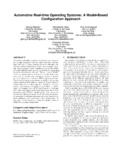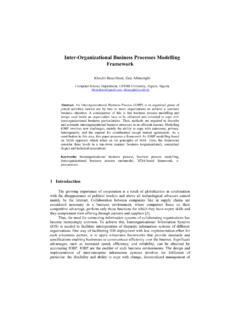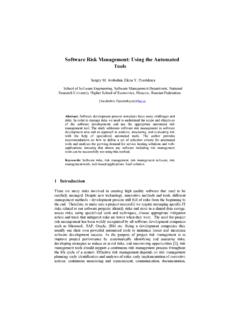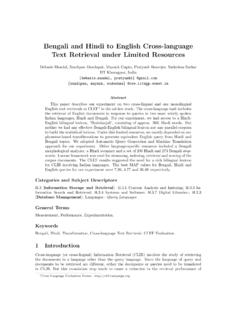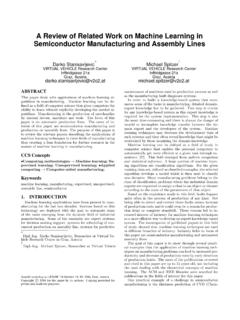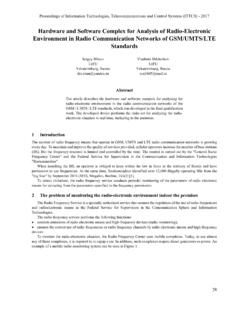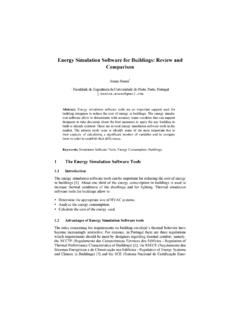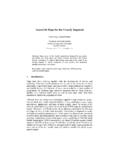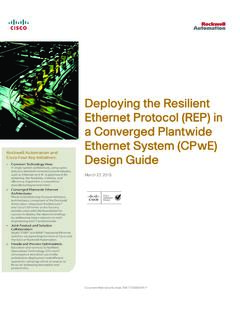Transcription of Deploying Model-Based Systems Engineering in Thales …
1 Deploying Model-Based Systems Engineering in Thales Alenia Space Italia Elvira Cali , Fabio Di Giorgio Thales Alenia Space Italia Via Saccomuro, 24 00131 Roma, Italia Mauro Pasquinelli Thales Alenia Space Italia Strada Antica di Collegno, 253 - 10146 Torino, Italia Copyright 2016 da Elvira Cali . Permesso concesso a AISE di pubblicare e utilizzare. Abstract In the last decade, Thales Alenia Space started studying the transition of its own Systems Engineering methods from standard requirement and document based ones to innovative approaches taking care of concurrent Engineering , enhanced collaboration, model based system Engineering methods and tools and tool-chains for overall Engineering environments.
2 In the field of system architectures analysis and definition, TAS has deployed internally a tooled-up approach, which is being extended to other system and multidisciplinary Engineering activities. Despite an investment needed to set-up the tooled-up approach, it allows to relate in a same model customer needs and architecture constraints, furthermore ensuring overall document consistency with the design by means of automatic documentation generation from the model , simplifying alignment in case of model update. Moreover, traceability links between requirements and model facilitate impact analysis for system evolution and maintenance, and will allow modifying the architecture baseline, taking care of previous justifications.
3 This paper presents an outline of the TAS Model-Based Engineering method (ARCADIA), of the use of the related tooling, and some examples derived from the application to space projects in the Domain Observation and Navigation Italy and in the Domain Exploration and Science Italy. Observed benefits of this approach, additional needs which have been managed (such as the extension of the approach to cover the geometry of the physical components) are presented in the conclusions. (Abstract) Keywords Systems Engineering ; Model-Based ; MBSE; tooled-up approach; Capella. I. INTRODUCTION As a Large system Integrator, Thales Alenia Space, like most of the Thales Group Entities, is very focused on system Engineering , which covers most areas of its activity spectrum, covering Observation, Navigation, Space Exploration and Science and Telecommunications.
4 Besides actively sponsoring the achievement of INCOSE CSEP (Certified system Engineering Professional) among its employees and with the goal of fostering a common tooled up approach and use of the same reference architectures, Thales has conceived a solution based on these core elements: a system Engineering methodology, called Sys-EM, which defines the successive stages of the overall Engineering process, a Model-Based Engineering method for Systems , hardware and software architectural design, called ARCADIA a Thales internal system modeling tool, Melody Advance, now released in the Open Source as Capella ( ) II.
5 ARCADIA AND CAPELLA A. Comparing ARCADIA vs. INCOSE approach ARCADIA (ARChitecture Analysis and Design Integrated Approach) is a Model-Based Engineering method for Systems , hardware and software architectural design. It has been developed by Thales between 2005 and 2010 [2] through an iterative process involving operational architects from all the Thales business domains (transportation, avionics, space, radar, etc.). Traditionally, emphasis has been put on a good definition of (mainly functional) requirements, and their allocation to each product item (broken down in subsystems, software, hardware ), and associated traceability.
6 This is clearly necessary, but in many cases, Engineering appears to be reduced to writing requirements and allocating them to some breakdown items, with little or no real analysis, design, check, justification of the relevant breakdown. Furthermore, this allocation of requirements is often only considered from the functional viewpoint, neglecting other "viewpoints" that usually strongly impact this breakdown, as for instance time performance allocation and safety drivers. Instead, ARCADIA recommends three mandatory interrelated activities, at the same level of importance: Copyright held by the authors. Need Analysis and Modeling Architecture Building and Validation Requirements Engineering Fig.
7 1. ARCADIA mandatory interrelated activities These activities will be carried out through the various detailed steps of the method. Fig. 2. Steps of ARCADIA method It is evident that the first activity, Need Analysis and Modeling is strongly related to the first Life Cycle Stage as defined by INCOSE SE Handbook [1], namely the Concept Stage, with the same focus on the Stakeholder needs and the definition of an Operational Concept (OpsCon or ConOps ) and Business Requirements as an input of the following Development Stage. In the Development Stage, again as defined by the SE Handbook, we pass from the Stakeholder needs to Stakeholder Requirements and to system Requirements, what the system has to accomplish to fulfill its Mission.
8 The system Requirements and a design activity leads thus to the definition of a (or more) solution(s) that meets the needs, focusing on how the system will work . Here, the concept of Viewpoints is stressed both in the INCOSE approach and in the ARCADIA Capella one. At this point, the INCOSE approach foresees the Design Definition process, aimed at providing sufficient detailed data [..] to enable the implementation [..] which is paralleled by the Physical Architecture step in ARCADIA / Capella. While this description, as depicted in fig. 2, seems to dictate a sequential approach, this is not necessarily the case, with several refinements steps leading to loops and iterations.
9 This is also conceived in the ISO/IEC TR 24748-1 [2] and reported in fig. in the INCOSE SE Handbook [1], and the Capella tool supports this by means of traceability between levels and additional capabilities ( diff/merge, libraries, ..). B. From Method to Tool: Capella Capella is an Eclipse based Open-Source system modeling tool, originally developed by Thales Group as Melody-Advance (part of Orchestra system Engineering workbench solution). It embeds ARCADIA method to guide users and relies on UML/SysML widely known standards, but uses a natural Engineering semantic (functions, components, ): Capella embeds a methodology browser, reminding ARCADIA principles to the user and providing efficient methodological guidance It should be highlighted that SysML is a language, not a methodology: it provides a vocabulary, but tells nothing about using one or the other concept, about structuring models or about following design rules, etc.
10 The Capella interpretation of the SysML specification is built on the following main drivers: Provide engineers all the expression means they need Avoid overwhelming engineers with unnecessary complexity Help engineers following the Thales methodologies Unify the way Systems and software architectures are modeled across Thales As such: A large part of the Capella concepts are directly coming from a subset of UML/SysML ones. For example, classes, properties, parts, ports, interfaces, actors, interaction model , state machines, etc. Some concepts are a Thales specialization of SysML concepts. For example, a SysML block does not exist as such in Capella.
